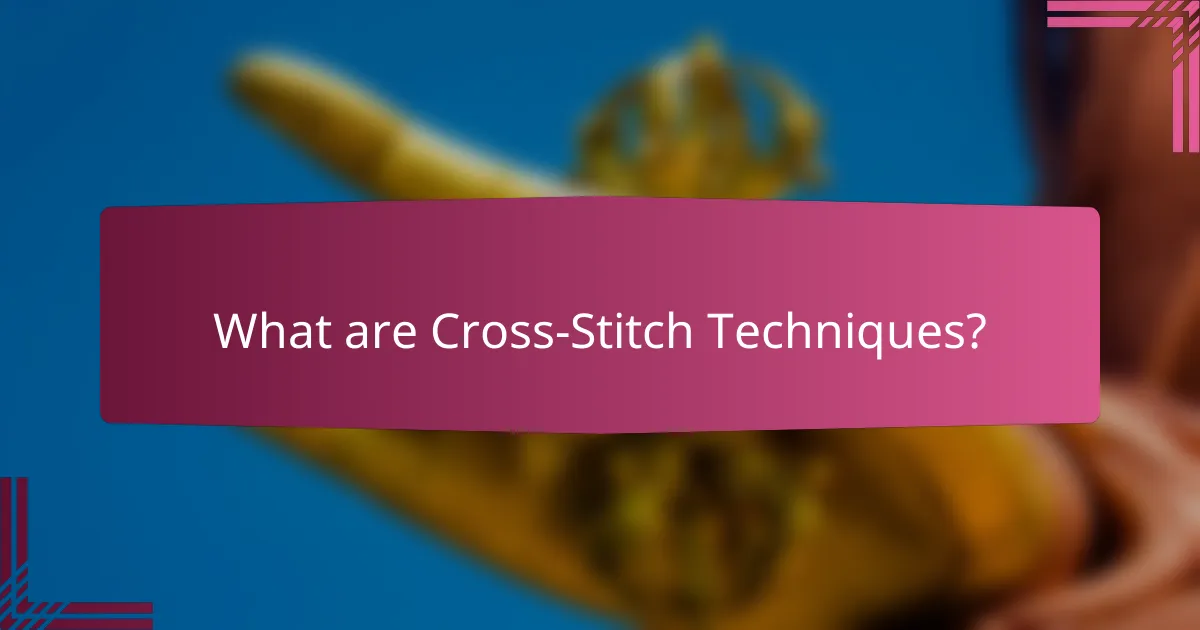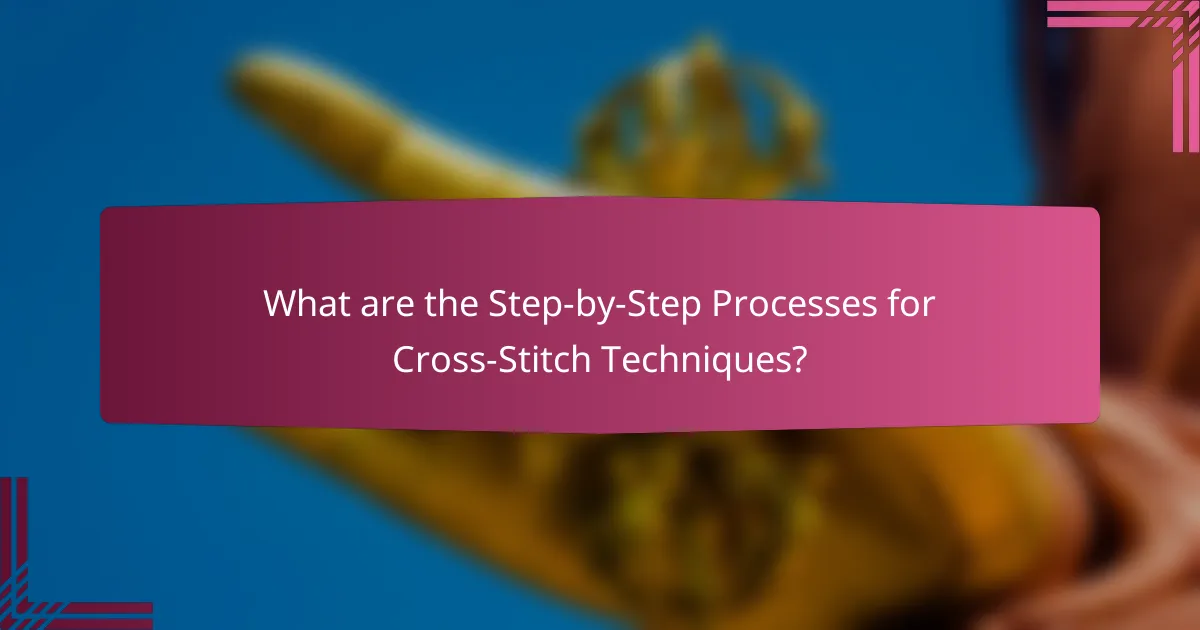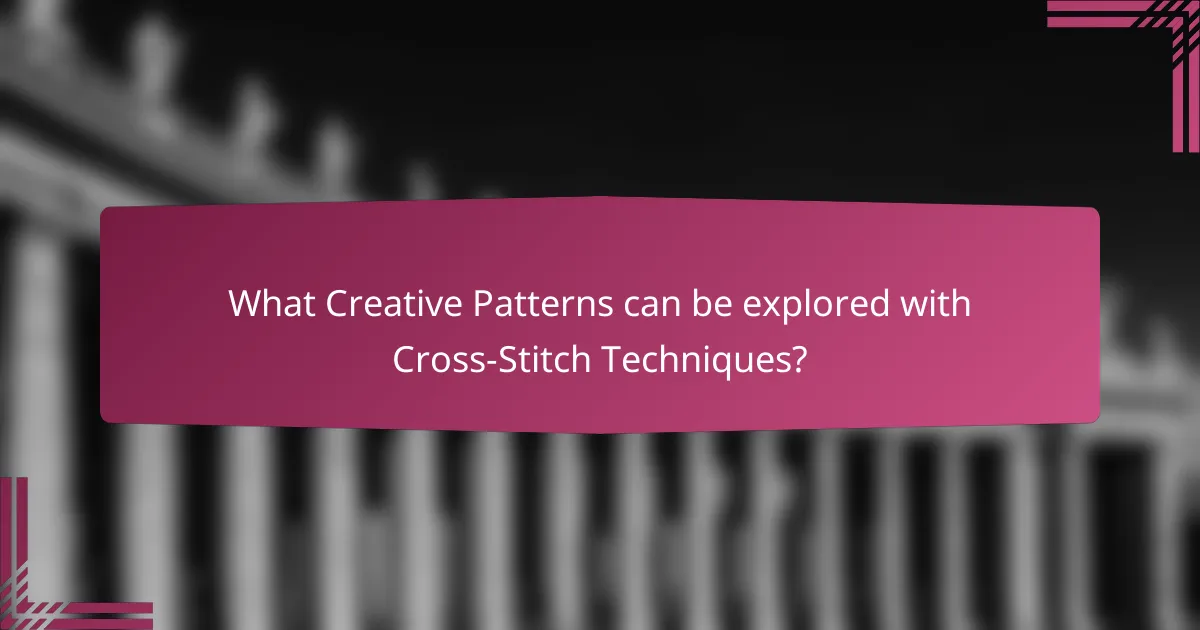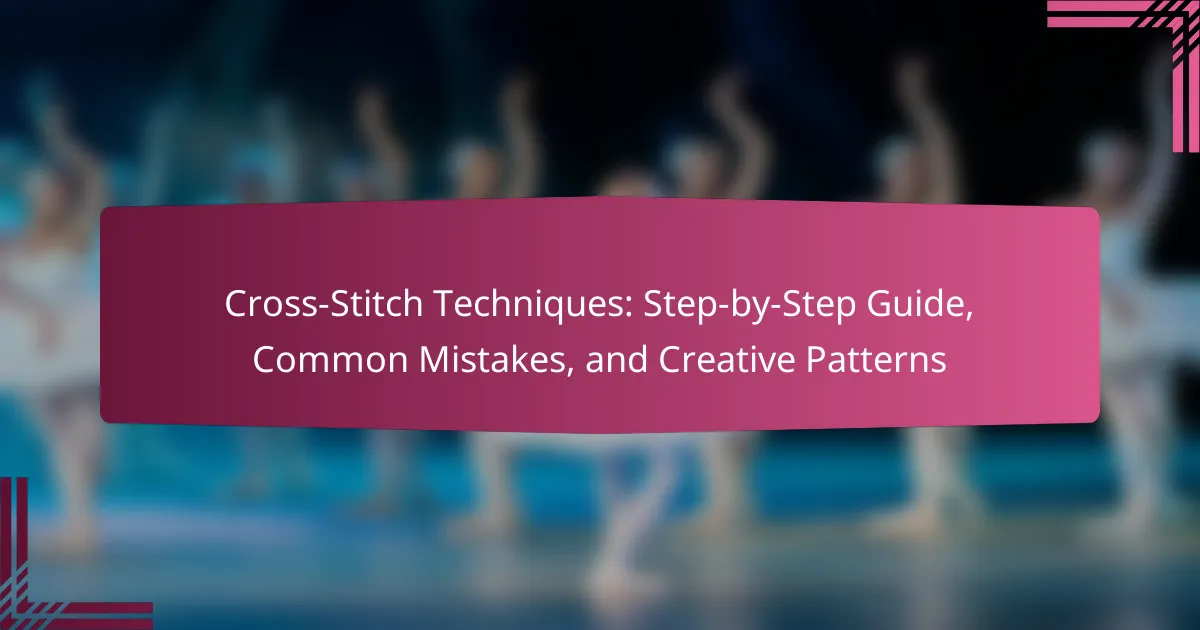
What are Cross-Stitch Techniques?
Cross-stitch techniques are methods used to create designs on fabric using a needle and thread. These techniques include basic stitches, such as the X-stitch, which forms the foundation of cross-stitching. Additional techniques encompass variations like half-stitches and backstitching for outlining. Advanced methods may involve blending threads or using specialty stitches for texture. Each technique contributes to the overall design and complexity of the finished piece. Mastery of these techniques allows for greater creativity in patterns and designs. Cross-stitching has historical roots dating back to the 6th century, showcasing its long-standing popularity.
How do Cross-Stitch Techniques differ from other embroidery methods?
Cross-stitch techniques differ from other embroidery methods primarily in their execution and design. Cross-stitch involves creating X-shaped stitches on a fabric grid, typically using counted thread techniques. Other embroidery methods, such as satin stitch or chain stitch, use different stitch forms and may not rely on a grid pattern. Cross-stitch is often used for creating pixelated images or patterns, whereas other techniques can produce more fluid and intricate designs. The simplicity of cross-stitch makes it accessible for beginners, contrasting with the complexity of some other embroidery styles. This distinction in technique and design approach highlights the unique nature of cross-stitch within the broader embroidery category.
What are the basic stitches involved in Cross-Stitch Techniques?
The basic stitches involved in Cross-Stitch techniques are the Cross Stitch, Half Stitch, and Back Stitch. The Cross Stitch is the most fundamental stitch, forming an ‘X’ shape on the fabric. It is created by making diagonal stitches that intersect. The Half Stitch, or half cross stitch, is a variation that consists of only one diagonal stitch. This stitch is often used for shading and creating softer edges. The Back Stitch is used for outlining designs and adding detail to the work. It is made by stitching backward along the line of a design. These basic stitches are foundational for various patterns and designs in cross-stitching.
What tools and materials are essential for Cross-Stitch Techniques?
Essential tools and materials for cross-stitch techniques include embroidery floss, aida cloth, and a needle. Embroidery floss is a six-strand thread available in various colors. Aida cloth is a fabric with a grid pattern that makes counting stitches easier. A needle, typically a tapestry needle, has a larger eye for easy threading. Additionally, scissors are necessary for cutting threads. A hoop or frame can help keep the fabric taut while stitching. Finally, a pattern guide provides the design to follow. These items are fundamental for successfully executing cross-stitch projects.
Why are Cross-Stitch Techniques popular among crafters?
Cross-stitch techniques are popular among crafters due to their accessibility and versatility. They require minimal materials, making them easy to start. Crafters can use various fabrics and threads, allowing for creative expression. The patterns can range from simple to complex, catering to different skill levels. This adaptability appeals to both beginners and experienced artisans. Additionally, cross-stitching offers a meditative quality, promoting relaxation. Many crafters appreciate the sense of accomplishment from completing projects. The community surrounding cross-stitching is vibrant, providing support and inspiration through shared patterns and ideas.
What benefits do Cross-Stitch Techniques provide for beginners?
Cross-stitch techniques provide several benefits for beginners. They enhance fine motor skills through repetitive hand movements. Beginners can develop patience as they focus on completing intricate patterns. Cross-stitching also promotes relaxation and mindfulness, reducing stress levels. Additionally, it fosters creativity by allowing individuals to choose colors and designs. Beginners can experience a sense of accomplishment upon finishing projects. This craft also encourages social interaction in community groups or online forums. Lastly, cross-stitching is an affordable hobby, requiring minimal supplies to start.
How can Cross-Stitch Techniques enhance creativity and relaxation?
Cross-stitch techniques enhance creativity and relaxation by providing a structured yet flexible medium for artistic expression. Engaging in cross-stitch allows individuals to focus on intricate patterns and color combinations. This focus can lead to a meditative state, reducing stress and promoting relaxation. The repetitive motions involved in stitching can also create a calming rhythm. Studies show that engaging in crafts, like cross-stitch, can lower cortisol levels, which is a stress hormone. Furthermore, completing a project can boost self-esteem and provide a sense of accomplishment. This combination of creativity and relaxation makes cross-stitch a beneficial activity for mental well-being.

What are the Step-by-Step Processes for Cross-Stitch Techniques?
The step-by-step processes for cross-stitch techniques include several key actions. First, gather your materials, including fabric, thread, and a needle. Second, select a pattern that you wish to stitch. Third, prepare your fabric by marking the center point. Fourth, thread your needle and tie a knot at the end of the thread. Fifth, start stitching by bringing the needle up from the back of the fabric. Sixth, create the first stitch by going down diagonally to form an ‘X’. Seventh, continue to follow the pattern, completing each stitch as indicated. Eighth, finish by securing the thread at the back of the fabric. Each step is essential for achieving a neat and accurate cross-stitch design.
How do you start a Cross-Stitch project from scratch?
To start a cross-stitch project from scratch, gather your materials first. You will need embroidery floss, aida cloth, a needle, and scissors. Choose a design or pattern that you want to stitch. Next, prepare your fabric by cutting it to size and securing it in an embroidery hoop if desired. Thread your needle with floss, tying a knot at the end. Begin stitching according to your pattern, counting threads carefully. It is essential to maintain even tension for consistent stitches. Following these steps ensures a successful start to your cross-stitch project.
What are the key steps to prepare your fabric and design?
The key steps to prepare your fabric and design for cross-stitch include selecting the fabric, choosing the design, and gathering materials. First, select a fabric suitable for cross-stitch, such as Aida or linen. Next, choose a design that fits your skill level and desired outcome. Gather necessary materials, including embroidery floss, needles, and scissors. Pre-wash the fabric if needed to prevent shrinkage. Then, hoop the fabric to keep it taut while stitching. Finally, transfer the design onto the fabric using a method like tracing or marking. These steps ensure a smooth and successful cross-stitching experience.
How do you properly execute the stitches in Cross-Stitch Techniques?
To properly execute stitches in cross-stitch techniques, follow these steps. Start by bringing the needle up through the fabric at the desired point. Insert the needle diagonally down into the fabric one square away. Pull the thread through completely. Next, bring the needle back up through the fabric diagonally in the opposite direction, creating an ‘X’ shape. Repeat this process for each stitch, ensuring even tension on the thread. Consistent tension helps maintain the stitch’s shape. Use a grid or pattern as a guide to ensure accuracy. This method is widely accepted in cross-stitching and is essential for creating neat and uniform designs.
What are common mistakes to avoid in Cross-Stitch Techniques?
Common mistakes to avoid in cross-stitch techniques include not counting threads accurately. Miscounting can lead to misaligned stitches. Another mistake is using the wrong fabric type. Choosing inappropriate fabric can affect the final appearance. Failing to secure threads properly can result in unraveling. Not using a hoop or frame may cause distortion in the fabric. Additionally, neglecting to follow the pattern closely can lead to errors in design. Lastly, using poor-quality thread can affect durability and texture. These mistakes can significantly impact the quality of the finished piece.
How can you identify and correct errors in your stitching?
To identify and correct errors in your stitching, first examine your work closely. Look for uneven tension or misplaced stitches. Check for skipped stitches or incorrect colors. Use a ruler to measure sections for alignment. If you find an error, carefully unpick the stitches. Replace them with correct ones, ensuring proper placement. Consistent practice helps improve accuracy. Regularly reviewing your work aids in error detection.
What are the best practices for maintaining tension and alignment?
The best practices for maintaining tension and alignment in cross-stitch involve consistent thread tension and careful placement of stitches. Ensure that the thread is neither too tight nor too loose to avoid distortion. Use a hoop or frame to hold the fabric taut while stitching. This prevents fabric shifting and maintains alignment. Always count stitches accurately to keep patterns aligned. Regularly check the back of the work to ensure the thread is consistent. Following these practices leads to a neat and professional finish in cross-stitch projects.

What Creative Patterns can be explored with Cross-Stitch Techniques?
Creative patterns that can be explored with cross-stitch techniques include geometric designs, floral motifs, and personalized monograms. Geometric designs often feature repeating shapes and color blocks, making them visually striking. Floral motifs incorporate various flowers and leaves, allowing for vibrant and intricate creations. Personalized monograms add a unique touch, often combining initials with decorative elements. Other patterns include animals, landscapes, and seasonal themes. Each pattern can vary in complexity, catering to different skill levels. Many resources, like pattern books and online galleries, provide inspiration for cross-stitch enthusiasts.
What types of patterns are popular in Cross-Stitch Techniques?
Popular patterns in cross-stitch techniques include floral designs, geometric shapes, and seasonal themes. Floral designs often feature intricate arrangements of flowers and leaves. Geometric shapes provide a modern aesthetic with repetitive patterns. Seasonal themes celebrate holidays and special occasions, like Christmas or Halloween. Animal motifs are also favored, showcasing various creatures in vibrant colors. Personalized monograms add a unique touch to projects. Landscape scenes depict nature, offering detailed and scenic representations. These patterns are widely available in kits and online resources, making them accessible for crafters.
How can you adapt existing patterns for personal projects?
To adapt existing patterns for personal projects, start by analyzing the original design. Identify key elements such as color schemes and stitch types. Modify colors to suit your preferences or match a specific theme. Change the size of the pattern to fit your project’s dimensions. You can also combine elements from multiple patterns for a unique design. Experiment with different fabrics to alter the texture and appearance. Adjust the stitch count if necessary to maintain the integrity of the design. This approach allows for personalization while retaining the charm of the original pattern.
What resources are available for finding unique Cross-Stitch patterns?
Unique Cross-Stitch patterns can be found through various resources. Online platforms such as Etsy offer a wide range of original designs from independent creators. Websites like Pinterest provide visual inspiration and links to unique patterns. Additionally, dedicated cross-stitch blogs and forums often share exclusive patterns and ideas. Craft stores frequently carry pattern booklets and magazines featuring unique designs. Social media groups focused on cross-stitching can also be valuable for discovering new patterns. Furthermore, digital pattern marketplaces allow users to purchase and download unique cross-stitch patterns directly. These resources collectively expand the options available for enthusiasts seeking unique cross-stitch designs.
How can you combine Cross-Stitch Techniques with other crafts?
You can combine cross-stitch techniques with other crafts by integrating them into various projects. For example, add cross-stitch to quilting by stitching designs onto fabric squares before assembling the quilt. Another option is to incorporate cross-stitch into embroidery by using it as a base layer for more detailed stitching. You can also enhance home decor items like pillows and wall hangings by cross-stitching patterns directly onto the fabric. Additionally, use cross-stitch as embellishments on clothing, such as adding motifs to jackets or bags. This combination enriches the visual appeal and adds a personal touch to various crafts.
What are some innovative ways to use Cross-Stitch in home decor?
Cross-stitch can be innovatively used in home decor by creating wall art, decorative pillows, and table runners. Wall art can feature personalized designs or quotes, making a unique statement piece. Decorative pillows can incorporate cross-stitch patterns for a cozy touch. Table runners can showcase intricate designs, enhancing dining aesthetics. Additionally, cross-stitch can be used on curtains for a custom look. Framed cross-stitch pieces can serve as focal points in any room. Using contrasting colors can elevate the visual appeal of the decor. Finally, incorporating seasonal themes can keep the decor fresh and engaging.
How can Cross-Stitch Techniques enhance gift-making and personalization?
Cross-stitch techniques enhance gift-making and personalization by allowing for customized designs. These techniques enable crafters to create unique patterns tailored to the recipient’s preferences. Personalization can include names, dates, or specific motifs that hold significance. The tactile nature of cross-stitch adds a handmade quality that mass-produced gifts lack. This craftsmanship conveys thoughtfulness and effort, making the gift more meaningful. Studies show that handmade gifts are often perceived as more valuable and cherished. Cross-stitching can also incorporate various colors and stitches to match the recipient’s style. Overall, these techniques provide a creative outlet for expressing affection through personalized gifts.
What tips can improve your Cross-Stitch Techniques?
To improve your cross-stitch techniques, focus on using high-quality materials. Quality thread and fabric enhance the overall appearance of your work. Maintain consistent tension while stitching to avoid unevenness. This ensures a neat and professional finish. Use a needle appropriate for your fabric type to prevent damage. A larger needle can create bigger holes, while a smaller one is better for delicate fabrics. Practice the half cross-stitch technique for faster execution on larger areas. This method saves time and maintains a clean look. Additionally, keeping your workspace organized helps reduce mistakes. An orderly setup allows for greater concentration and efficiency.
How can you effectively organize your workspace for Cross-Stitching?
To effectively organize your workspace for cross-stitching, designate a specific area for your materials. Use a sturdy table or desk with adequate lighting to reduce eye strain. Keep your cross-stitch patterns, threads, and tools within easy reach. Utilize storage solutions like bins or drawers to categorize threads by color. A needle organizer can prevent loss and keep your workspace tidy. Use a comfortable chair to support long stitching sessions. Make sure to have a waste container nearby for thread scraps. This organization enhances focus and efficiency, leading to a more enjoyable stitching experience.
What are the best ways to stay motivated and inspired in Cross-Stitch projects?
Set clear goals for your Cross-Stitch projects to maintain motivation. Break larger projects into smaller, manageable tasks. This approach makes progress visible and achievable. Create a dedicated stitching space to inspire creativity. Surround yourself with tools and materials that spark joy. Join Cross-Stitch communities online or locally for support and inspiration. Engaging with others fosters motivation through shared experiences. Regularly explore new patterns and techniques to keep your interest alive. Experimenting with different styles can reignite your passion. Lastly, celebrate your completed projects, no matter how small. Acknowledging your achievements boosts confidence and encourages future stitching endeavors.
Cross-stitch techniques involve creating designs on fabric using various stitching methods, including basic stitches like the X-stitch, half-stitch, and backstitch. This article provides a comprehensive guide covering the step-by-step processes for executing cross-stitch, common mistakes to avoid, and tips for enhancing skills. It also explores creative patterns, tools, and materials essential for successful projects, as well as the benefits of cross-stitching for beginners. Additionally, the article discusses how to combine cross-stitch with other crafts and innovative ways to use it in home decor and gift-making.
